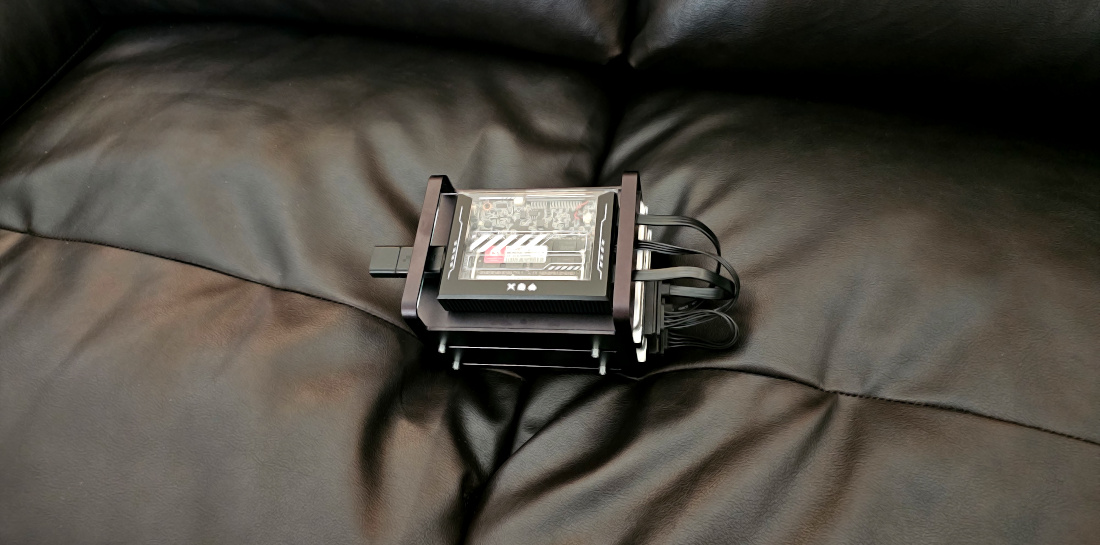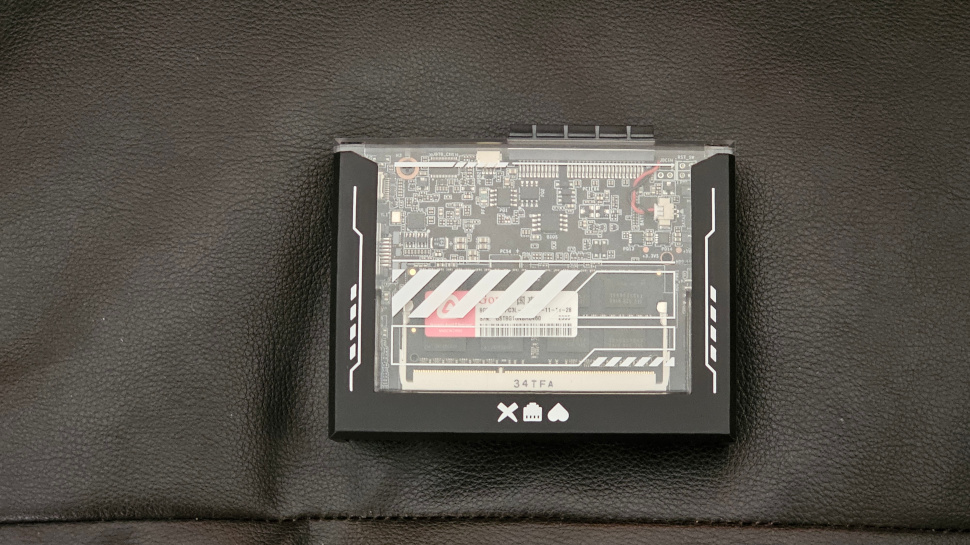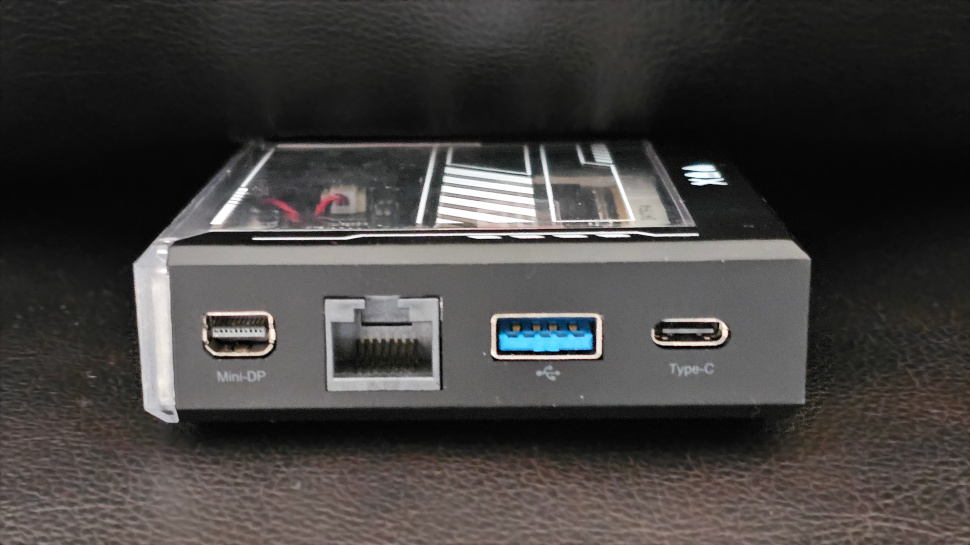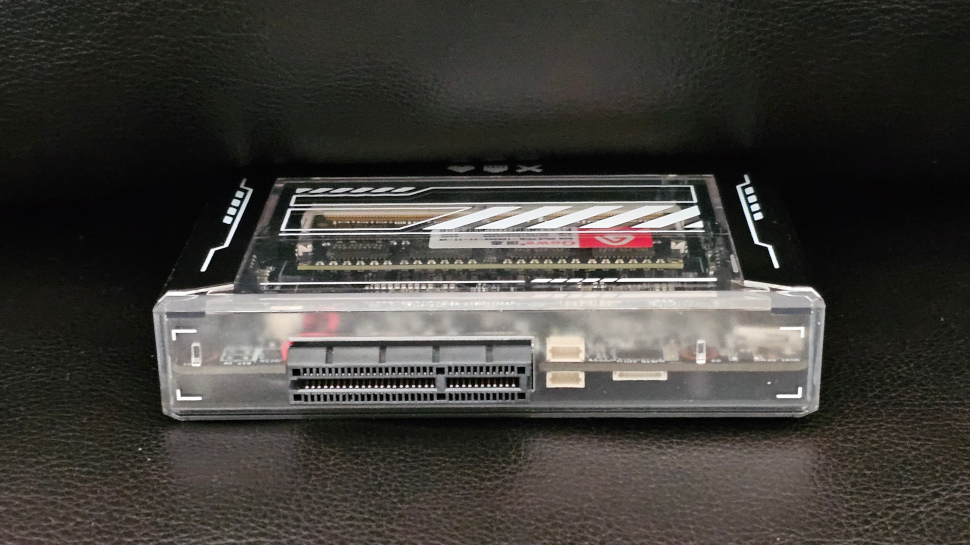
The ZimaBlade single-board computer looks surprisingly similar to an old-school portable cassette player.
CPU: Entry-level Dual-Core N3350, High-Performance Quad-Core J3455
GPU: Entry-level 650MHz, High-performance 750MHz, 12 execution units
RAM: Upgradable up to 16GB of DDR3L, none supplied in the box
FLASH: 32GB eMMC
USB: 1 x Type-C, 1 x USB3.0, 2 x internal USB2.0
Display: 1 x 4K MiniDP, 1 x DP over Type-C, 1 x eDP internal
PCIe: Four lanes 2.0
SATA: 2 x SATA3.0
Ethernet: 1 x Gigabit LAN
Power Consumption: About 15W
Size: 107mm x 80mm x 32mm
It competes with the Raspberry Pi 4, being in the same price bracket while offering an Intel x86 architecture. The SBC has plenty of connectors, which makes this hacker-friendly platform versatile and unique. The built-in PCIe 2.0 x4 connector accepts various cards out-of-the-box, and with two SATA3 ports, the board can morph into a portable NAS storage device.
Since the ZimaBlade supports up to 16GB of DDR3L, it can run applications requiring large amounts of memory, such as databases and VMs. The main let-down is the outdated CPU, with the speediest version of the board based on a Quad-Core 2.3GHz Apollo Lake CPU. The SBC features a single USB Type-C, which supplies power and drives a DisplayPort output.
IceWhale Technology, the maker of the ZimaBlade, held a Crowdsupply campaign to finance the board's new version. Various perks are available; the most basic, containing a Dual-Core Intel Celeron N3350, is available for $64. The ZimaBlade 7700, built around a Quad-Core J3455 CPU, sells for $96. Except for the CPU, both have the same hardware and require a DDR3L memory module to boot.

ZimaBlade: Design
The ZimaBlade computer comes with a male-to-male Type-C and one SATA cable. The passively cooled unit measures 107mm x 80mm x 32mm and weighs 175g. The small case sits perfectly flat on a desk, with no mounting holes and only four tiny rubber pads on the bottom. Being very light, connecting various cables can become problematic as the case can topple easily.
The Zimablade designers have worked hard to produce an enclosure that showcases the computer’s internal components. A transparent plastic top displays the SODIMM memory but not the CPU. With no power button available, the hardware turns on when plugging a Type-C cable. A single status LED, barely visible from the side of the case, indicates if the board is powered. The PCIe socket location does not allow easy card insertion. The card’s metal bracket has to be removed before use.
Under the hood, the ZimaBlade sports a J3455 quad-core Intel Celeron CPU clocked at 2.4GHz for the highest performance board variant. Geekbench shows the ZimaBlade handily outperforms the Cortex A72 ARM CPU found in the Pi4 but scores well below the new Pi5’s Cortex A76 CPU. One aspect not found on similar-priced platforms is expanding the memory to 16GB using DDR3L SODIMM.
The ZimaBlade targets an audience that strives for high-speed interfaces. Seven connectors provide connectivity for many use cases with throughputs above the gigabit mark. Two SATA6 and one Gigabit Ethernet socket turn the ZimaBlade into a redundant storage server. One USB3, a USB Type-C with DP, and a mini-DP connector capable of 4K at 60Hz complete the list of external ports. Three internal connectors, two USB 2.0 connectors, and one eDP socket allow additional peripherals.

ZimaBlade: In Use
The owner can use the ZimaBlade simply by plugging a USB Type-C cable into a screen supporting a Type-C display. The computer then boots CasaOS, a lightweight cloud-accessible platform with an ever-increasing number of applications. ZimaBlade is extremely fast at booting, taking just five seconds to display the Linux login.
After entering the default username and password, the user has root access to the Linux-based OS stored in 32GB eMMC storage, with 24GB left for user applications. A lean OS means a lowly 20% RAM utilization with an 8GB memory module. With the 1G LAN connected, software updates run automatically and keep the platform secured.
In addition to being affordable, the ZimaBlade builds on a user-friendly OS where the UI is viewed entirely through a web browser. This cloud concept could have been a miss, but thanks to modern technologies like Docker containers, using the desktop is very snappy. The installed software includes a file explorer and an app store containing forty applications ranging from a retro emulator to home automation.
Running Geekbench6 on the ZimaBlade involves installing through SSH. The board's power consumption reaches 15W, with the case becoming
hot at more than 60 degrees Celsius, and decreases to 6W when idle. With a score of 300 in single-core and 911 in multi-core benchmarks on Geekbench6, the J3455 CPU won’t blow you away with its computing prowess but will be sufficient for everyday basic tasks.

ZimaBlade: The competition
Thanks to the ZimaBlade, finding an affordable x86 single-board computer with lots of connectivity and expandable memory has become more accessible. Hardkernel’s Odroid H3+ is very similar to the ZimaBlade, being passively cooled and possessing various high-speed connectors. The H3+ costs more than twice as much, with the Odroid H3+ being bigger with an oversized heatsink and consuming more power. The quad-lane PCIe connector on the ZimaBlade makes it a valuable testbed for PCIe cards, something not found in the Odroid H3+.
ZimaBlade: Final verdict
IceWhale’s ZimaBlade makes a tremendous entry-level computer with many options for adding extra hardware. The PCIe slot is the product's standout feature, allowing the use of high-end gaming graphics cards, for example. The single SODIMM socket gives the user an upgrade path to more memory. The onboard eMMC storage memory turns the unit into a self-contained product. Finally, a price below $100 tilts the balance, making the ZimaBlade a must-have gadget this year.







